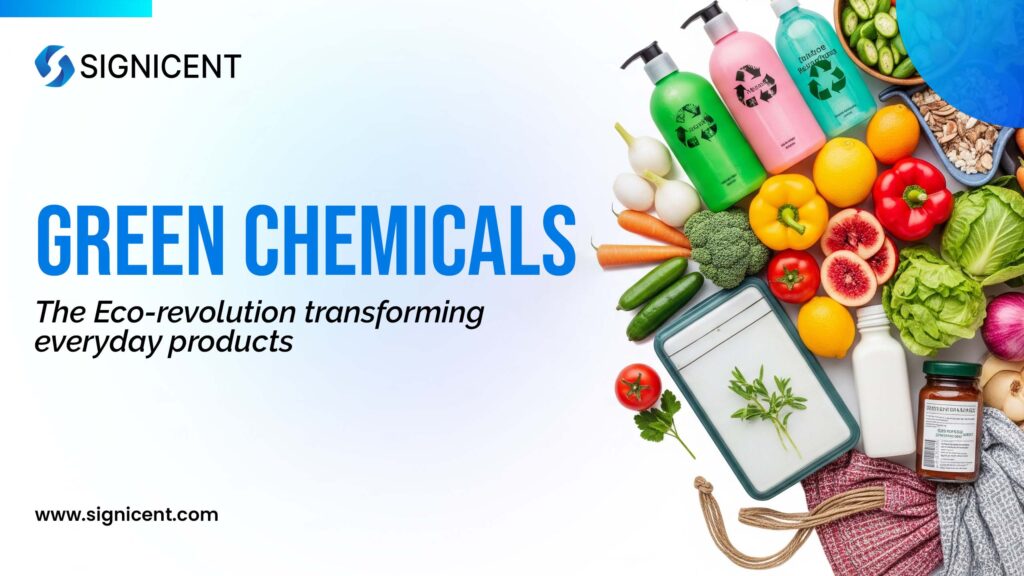Every day, we unknowingly rely on products filled with chemicals—like alcohols, aldehydes, and surfactants—that make up our soaps, cosmetics, cleaners, and even food packaging. While these compounds support our modern lifestyle, the aftermath often goes unnoticed. Once discarded, they seep into nature, contaminating soil, water, and even the air we breathe. These invisible intrusions quietly affect our health and slowly poison ecosystems.
But what if chemistry could evolve to heal rather than harm? What if the very waste we generate—plastic wrappers, used containers, industrial refuse—could become the starting point for sustainable innovation?
This is where green chemicals come in. Born from renewable sources and innovative recycling technologies, green chemicals present a hopeful path. They promise to replace toxic compounds, minimize pollution, and realign industry with the planet’s well-being. It’s more than science—it’s our chance to rewrite the future of chemical use.
But why is this shift happening now? The answer lies in sustainability demands, technological advancements, and consumer awareness. Through technology landscape analysis, businesses are identifying breakthrough innovations in green chemistry—spotlighting renewable feedstocks, waste-to-chemical processes, and biodegradable alternatives. Green chemicals, derived from eco-friendly processes, promise to revolutionize industries while minimizing environmental harm and aligning with long-term ESG goals.
The Rise of Green Chemistry: What Are Green Chemicals?
Green chemicals are substances derived from renewable sources or developed using environmentally friendly processes that avoid hazardous reagents and by-products. Unlike their conventional counterparts, these materials are designed with both performance and planet in mind.
They include:
- Bioplastics replacing petroleum-based polymers
- Bio-pesticides reducing soil and water toxicity
- Green solvents improving safety in industries like paints, coatings, and pharmaceuticals
At the core of green chemistry is the goal to minimize environmental impact, support the circular economy, and meet rising consumer and regulatory demands.
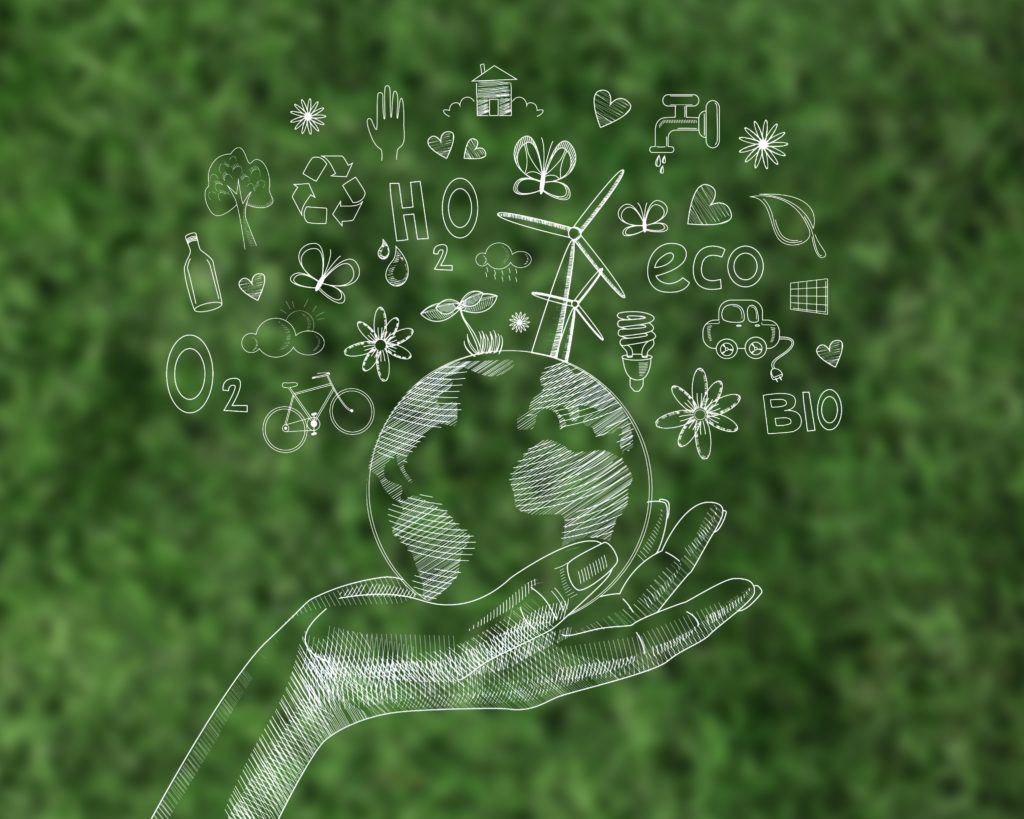
5 Reasons Why Green Chemicals Are the Industry’s Next Frontier
- Support for Global Climate Goals
By reducing emissions and enabling cleaner manufacturing, green chemicals are instrumental in reaching net-zero targets. - Boosting the Circular Economy
Designed for safe reuse or degradation, green chemicals reduce waste and pollution, creating more resilient supply chains. - Aligning with Consumer Expectations
As green preferences influence buying behavior, businesses that prioritize sustainability gain loyalty and competitive advantage. - Government Funding & Incentives
Public investments in green R&D, such as EU’s Horizon 2020, are accelerating innovation and adoption. - Long-Term Cost Benefits
Despite upfront R&D costs, process efficiencies and reduced raw material use make green chemicals financially viable over time.
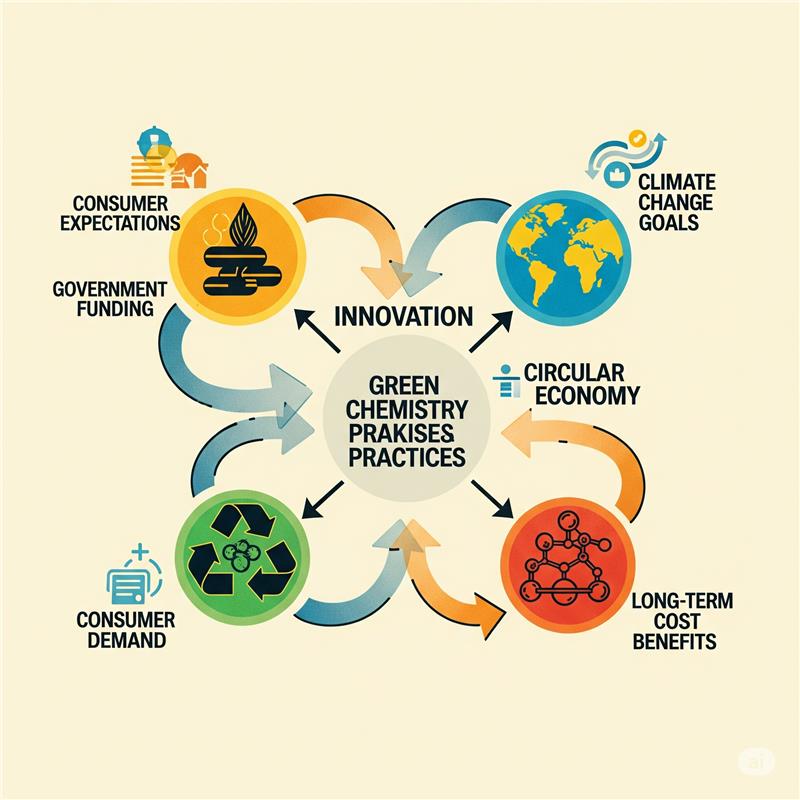
Innovation Spotlight – Soundwaves Turning PFAS Waste into Value
One of the biggest challenges in green chemical transition has been recycling materials like PFAS (Per- and polyfluoroalkyl substances)—dubbed “forever chemicals” due to their persistence in nature. But a recent breakthrough at the University of Leicester signals a turning point.
Researchers have developed an ultrasound-based technique that separates PFAS membranes from valuable catalysts in fuel cells—within seconds. This novel delamination method avoids harsh chemicals, allowing precious platinum group metals to be recovered cleanly and quickly.
This technological leap reflects the core promise of green chemistry: solve complex problems using clean, scalable, and sustainable science.
Traditional Chemicals vs. Green Chemicals – A Comparative Analysis

Challenges with Conventional Chemicals
Even the most ordinary products we use daily carry hidden consequences. These silent threats from conventional chemicals are now too dangerous to ignore—for us and for the planet. Through targeted innovations, many companies are trying to shift towards safer alternatives. However, entering the green chemical space requires more than invention—it demands strategic protection. That’s where a Patent Invalidation Search becomes crucial. It helps challenge weak or obstructive patents, clearing the path for sustainable solutions to thrive without legal roadblocks.
Below are some of the harsh realities and odd consequences we continue to face due to toxic chemicals in our environment:
- Forever Chemicals in Water
PFAS and similar synthetic compounds persist for decades, leaching into our water, soils, and food, endangering ecosystems and public health permanently. - Invisible Carbon in Every Drop
Every chemical manufactured using fossil fuels leaves a heavy carbon trail—fueling climate change far beyond what meets the eye. - Toxic Shadows in Daily Life
Industrial solvents and synthetic surfactants may enhance product performance but leave behind long-term risks like hormonal disruption and cancer. - Landfills Overflowing with Non-Recyclables
Over 60% of plastic-based chemical products cannot be recycled—leading to massive landfill piles and ocean gyres filled with harmful debris. - Bioaccumulation in Our Bodies
Some legacy chemicals are not just persistent—they build up inside humans and animals, disrupting immune systems, reproduction, and neurological health. - Pollution Beyond Borders
Airborne chemical residues and industrial runoffs do not recognize boundaries—polluting even the remotest ecosystems on Earth.
Innovative Solutions in Green Chemistry
These are the innovations transforming toxic pollution into eco-friendly breakthroughs—from plastic-eating enzymes to fuel-cell savers and plant-powered replacements for harmful chemicals
- Ultrasound-Assisted Recycling – Scientists now use sound waves to recycle PFAS-laced membranes in seconds—recovering precious catalysts and avoiding toxic landfill buildup from fuel cell waste.
- Bio-Based Feedstocks – Bio-based feedstocks from companies like Cargill replace harmful petrochemicals—offering renewable, biodegradable inputs without compromising industrial performance or quality.
- Biodegradable Plastics –Alternatives like PLA and PHA naturally break down—offering a compostable solution to replace persistent plastic waste in packaging and single-use items.
- Biodegradability & Catalysis – Enzymes act as nature’s own catalysts—working gently without harsh chemicals or high temperatures, making plastic breakdown cleaner, safer, and more eco-friendly overall.
- Waste Reduction – These smart enzymes break PET plastics into reusable building blocks, transforming waste into raw material and helping industries embrace truly circular, waste-free production models.
Green Chemistry through Plastic Waste Conversion
These solutions that alter plastic do more than just recycle and they also upcycle. Our perception of garbage and sustainability is evolving because of the conversion of common waste into green chemicals.
🔹 Pyrolysis & Thermal Depolymerization at the Core
Scientists are using heat-driven processes to break down non-biodegradable plastics like PE and PP into valuable chemicals—fueling a more circular future.
🔹 High-Value Chemicals from Low-Value Waste
From trash to treasure—these methods yield alcohols, surfactants, aldehydes, and detergents used across industries like pharma, agriculture, and manufacturing.
🔹 Beyond Recycling—This is Reinvention
Unlike conventional recycling, the process changes plastic at the molecular level—creating green, fossil-free alternatives for industrial chemistry.
🔹 Towards Net-Zero with Every Molecule
This breakthrough turns landfill-bound plastic into sustainable chemical inputs—offering a scalable solution for cleaner production and reduced emissions.
This innovation bridges the gap between waste management and resource generation, turning common trash into alcohols, aldehydes, surfactants, and detergents—all essential for industries ranging from pharmaceuticals to agriculture.
Unlike conventional recycling, these controlled heating methods go beyond reusing plastic—they transform its molecular structure, creating eco-friendly alternatives to fossil-derived chemicals. Such technologies not only reduce environmental load but also support a circular economy, promoting chemical sustainability at scale.
This breakthrough offers a strategic pathway toward net-zero emissions, ensuring that plastic no longer ends its life in landfills—but as a sustainable input for green chemistry.
Real-World Benefits of Green Chemicals
Green chemistry is not just a theory from the lab; it is revolutionizing actual industries by improving the safety of goods, the cleanliness of processes, and the health of our planet at every stage. A critical enabler of this transformation is Patent Chemical Structure Search, which allows innovators to identify sustainable molecular alternatives, avoid infringement, and accelerate eco-friendly product development.
Here are several significant advantages that are influencing the real world and shaping a sustainable future via astute, environmentally responsible innovations:
🔹 Reduced Pollution
Biodegradable materials decompose naturally, preventing harmful build-up in landfills and oceans while protecting ecosystems from long-term microplastic and chemical contamination.
🔹 Lower Carbon Emissions
Switching to renewable feedstocks like plant-based inputs significantly reduces fossil fuel dependency—slashing emissions from chemical production and improving air quality.
🔹 Regulatory Compliance
Green chemistry aligns with global environmental policies, helping companies meet EPA, EU Green Deal, and other sustainability frameworks without legal risk.
🔹 Economic Viability
Using greener inputs cuts down on energy-intensive processes, waste disposal costs, and material inefficiencies—resulting in long-term operational and financial benefits.
🔹 Brand Value & Innovation
Embracing green chemistry boosts public image, attracts eco-conscious consumers, and drives innovation in product development with sustainable, future-ready solutions.
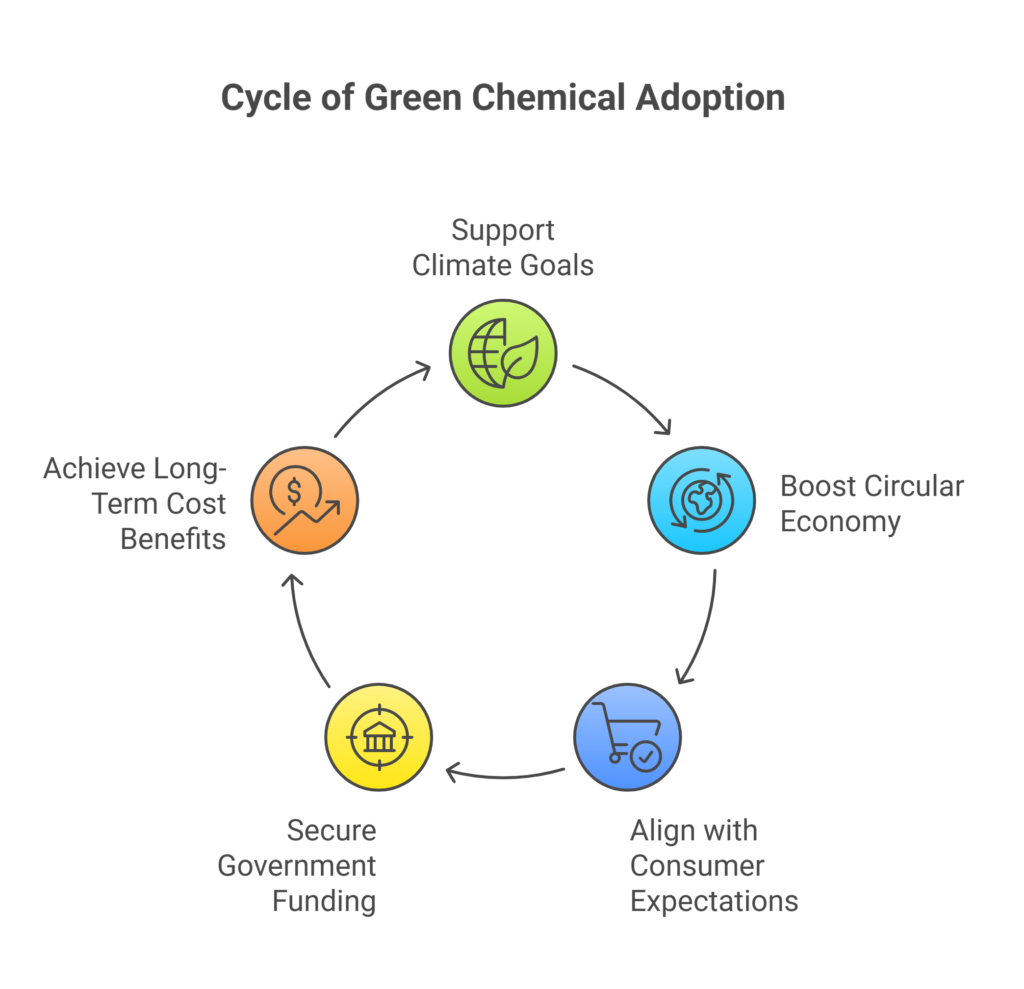
Global Green Chemistry Market Trends
The market for green chemistry is expanding rapidly on a global scale due to the pressing need to meet consumer demand for sustainable products, minimize chemical pollution, and adhere to stringent environmental regulations.
Businesses in a variety of sectors, including packaging, agriculture, cosmetics, and medicines, are embracing environmentally friendly substitutes like low-toxicity solvents, bio-based feedstocks, biodegradable plastics, and enzyme catalysis.
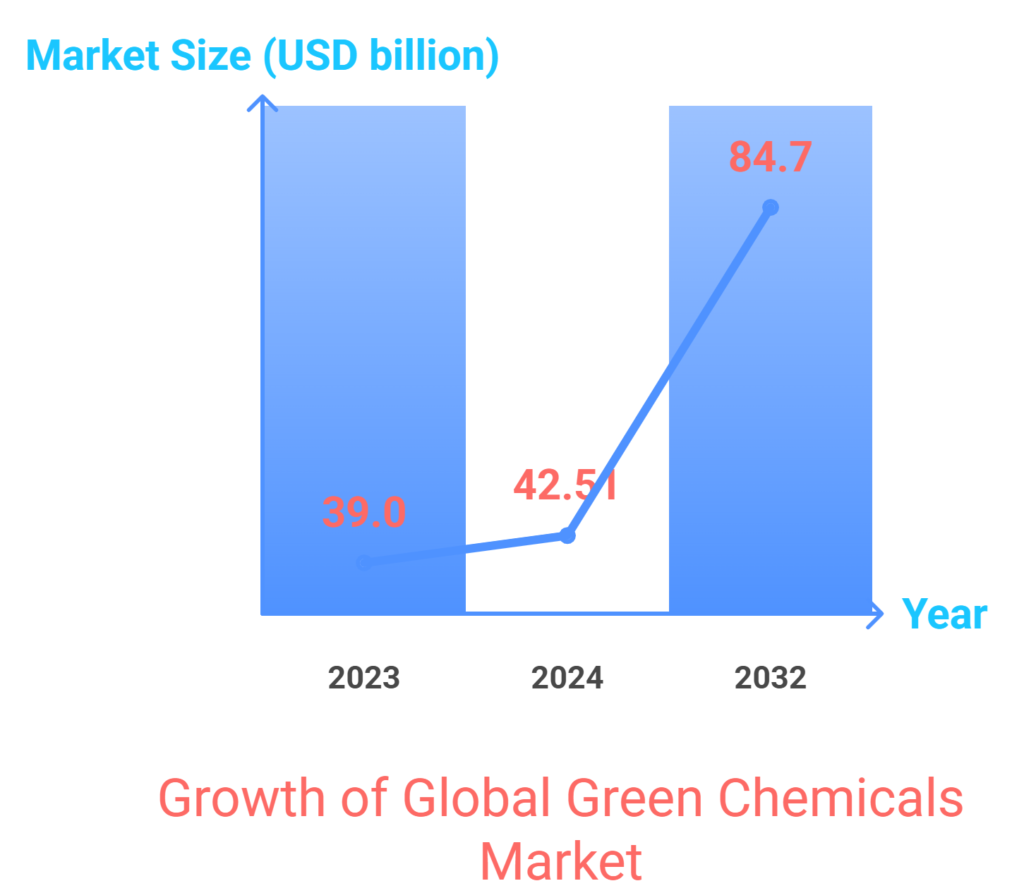
As per Signicent Market Research, the global green chemicals market is projected to grow at a 12% CAGR between 2025 and 2035, reflecting a strong global shift toward sustainable industrial practices.
The trends below are visualized in the accompanying graph, highlighting regional adoption, investment growth, and application-specific integration—ranging from biodegradable packaging and green solvents to sustainable agriculture and waste valorization.
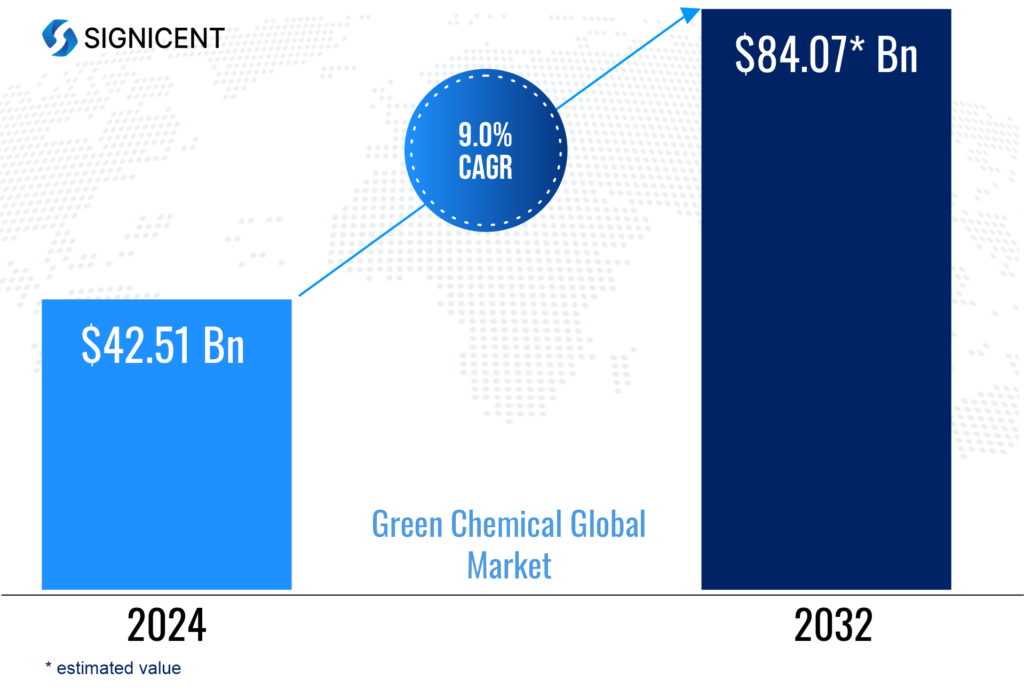
Key Players in Green Chemicals
These companies are leading the transition from toxic compounds to sustainable, circular, and bio-based alternatives—fueling the green chemistry revolution across industries.
BASF – Pioneering green hydrogen production and eco-friendly catalysts for energy-efficient and low-emission chemical processes.
Dow Chemical – Focused on circular packaging solutions and developing bio-based plastics that reduce dependence on fossil fuels.
DuPont – Innovating safer chemistry with non-toxic flame retardants and sustainable materials for electronics and construction.
Cargill – Producing plant-based industrial chemicals and biodegradable polymers, supporting both agriculture and manufacturing sectors.
DSM-Firmenich – Advancing bio-based additives, enzymes, and nutraceuticals through sustainable fermentation and green synthesis techniques.
Arkema – Developing high-performance biopolymers and green solvents for automotive, electronics, and construction applications.
Clariant – Specializing in renewable surfactants, natural emulsifiers, and circular additives for personal care and industrial formulations.
Signicent supports green chemistry pioneers by delivering deep technological landscape studies across biodegradable materials, plastic upcycling, sustainable solvents, and plant-based feedstocks. Our patent analytics uncover innovation gaps and whitespace in chemical synthesis, catalysis, and waste valorization—empowering clients to align their R&D with future-ready, eco-conscious breakthroughs. We actively scout emerging green startups, assess cutting-edge chemical technologies, and identify licensing and partnership opportunities that promote sustainable product pipelines.
In addition, we provide regulatory intelligence and Freedom To Operate (FTO) assessments to help companies comply with global green mandates, including REACH, EPA, and EU Green Deal frameworks. Our competitive benchmarking and sustainability roadmaps help clients lead in green innovation, optimize costs, and reposition traditional portfolios toward circular economy models. With Signicent’s strategic insights, companies can scale greener products, reduce environmental footprint, and seize first-mover advantage in the fast-evolving sustainable chemicals landscape.
Future Outlook: What’s Next for Green Chemicals?
From AI-powered material design to zero-waste manufacturing, green chemicals are set to redefine the next decade of sustainable industrial innovation.
AI-Driven Discovery
Designing biodegradable plastics, surfactants, and low-impact chemical compositions will be revolutionized by machine learning, which will release new green compounds more quickly.
Circular Process Integration
Businesses will incorporate upcycling and chemical recycling into production processes to minimise waste and increase resource efficiency throughout international supply chains.
Tightening Regulations
Global bans on harmful substances like PFAS and microplastics will accelerate the demand for clean, compliant alternatives in multiple sectors.
Green Chemistry in Pharma
Eco-friendly solvents, enzymatic synthesis, and biocompatible reagents will become essential in drug manufacturing and pharmaceutical production pipelines.
Decentralized Biorefineries
Modular green chemical plants near waste sources will rise—offering real-time plastic conversion, biomass valorization, and reduced carbon transport footprints.
FAQs on Green Chemicals
1. What are green chemicals?
Green chemicals are eco-friendly substances made from renewable sources, designed to reduce harm to the planet across industries and applications.
2. How do green chemicals reduce pollution?
They’re biodegradable, non-toxic, and often upcycled from waste—preventing long-term contamination in oceans, soils, and ecosystems while supporting cleaner production cycles.
3. Are green chemicals cost-effective?
While upfront costs may be higher, businesses benefit from long-term savings through energy efficiency, reduced waste, and meeting strict environmental regulations.
4. Which industries benefit most from green chemicals?
Packaging, agriculture, energy, and cosmetics industries are rapidly adopting green chemicals to align with sustainability goals and enhance environmental responsibility.
5. How is Signicent contributing to green chemistry?
Signicent enables companies to transition sustainably, offering innovation scouting, upcycling solutions, and chemical insights that turn plastic waste into industrial value.
About Signicent LLP
We assist businesses globally in their technology innovations, R&D, new product development, patents, valuation, product commercialization & market research needs.
Services Offered:
- Patent Landscape
- Patent Portfolio Analysis
- Patent Invalidity Search
- Patent Licensing Services
- Freedom to operate (FTO)
- Chemical Structure Search
- Design Patent Search
- Technology Scouting
- Technology Landscape Analysis
- Technology gap analysis
- Technology Intelligence
- Market Research
- Bio Sequence Search
Elevate your Innovation and Research with Signicent’s cutting-edge approach to assist you with Technology and Market related matters alongside the IP aspect of the analysis.


